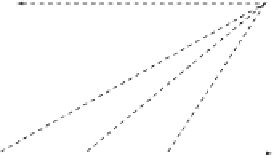Graphics Programs Reference
In-Depth Information
x
P
Limit
increase
x
coordinates
P
1
P
2
z
(a)
(b)
Figure 3.23: (a) Large
x
Dimensions. (b) Large Values of
k
.
1. The
z
coordinates are increased. We select two object points
P
1
=(
x
1
,y
1
,z
1
)
and
P
2
=(
x
1
,y
1
,z
2
)withthesame
x
and
y
coordinates and different
z
coordinates.
We denote their projected points by
P
1
=(
x
1
,y
1
)and
P
2
=(
x
2
,y
2
) and compute the
ratio
x
1
/x
2
:
x
1
x
2
x
1
(
z
1
/k
)+1
(
z
2
/k
)+1
=
z
2
+
k
x
1
=
z
1
+
k
.
(3.3)
When the
z
coordinates are increased, this ratio approaches 1, thereby showing that
the distance between the projected points is decreased, resulting in less perspective.
2. The
x
or
y
coordinates are increased. Equation (3.2) shows that the projected
points get closer in this case, too.
3. The value of
k
is increased. In this case, Equation (3.3) shows that the projected
points get closer, again implying less perspective.
Condition 3 is also easy to verify, at least in the case of lines parallel to the
z
axis. Figure 3.24 shows how a group of lines parallel to the
z
axis are projected to line
segmentsthatconvergeattheorigin.
x
z
Figure 3.24: Lines Parallel to the
z
Axis.
Step 4
. The projection expressed by Equation (3.1) can be included in the general
4
×
4 transformation matrix in three dimensions [Equation (1.23)]. The result is
⎛
⎞
1000
0100
000
r
0001
⎝
⎠
T
p
=
.
(3.4)






















Search WWH ::

Custom Search